For the most part, most accessories including guitar stands are completely harmless, but there are a lot of people on the internet who have discovered the rare exceptions where a guitar’s finish can chemically interact with the chemicals used to create the stand.
There are two main issues with guitar stands: one has to do deal with the stability of cheaper models for which the solution is simple, while the other has to do with a chemical reaction between the rubber of the stand and the nitrocellulose finish used by manufacturers a long time ago. So what’s the deal, are they really that bad?
Guitar stands won’t hurt your guitar, but models in poor condition may lack stability. Additionally, the rubber material often used in these stands can react with the nitrocellulose finish found on vintage guitars. Although it’s not necessary, it’s wise to buy a premium, nitrocellulose-safe stand.
Worrying about a guitar stand and its safety is kind of missing the forest for the trees, to put it one way. Chances are if you’re the type of person who has dozens of guitars, many of which are quite expensive and vintage, there is also a good chance you’ve already realized the advantage of premium guitar stands.
Reason would suggest that a beginner, on the other hand, probably doesn’t have 12 guitars (nor do they need that many as I explained here), so one budget stand is fine. Moreover, beginners usually don’t have nitrocellulose guitars anyway unless they just so happened to stumble upon a vintage model.
How Could A Guitar Stand Be Bad For Your Guitar?
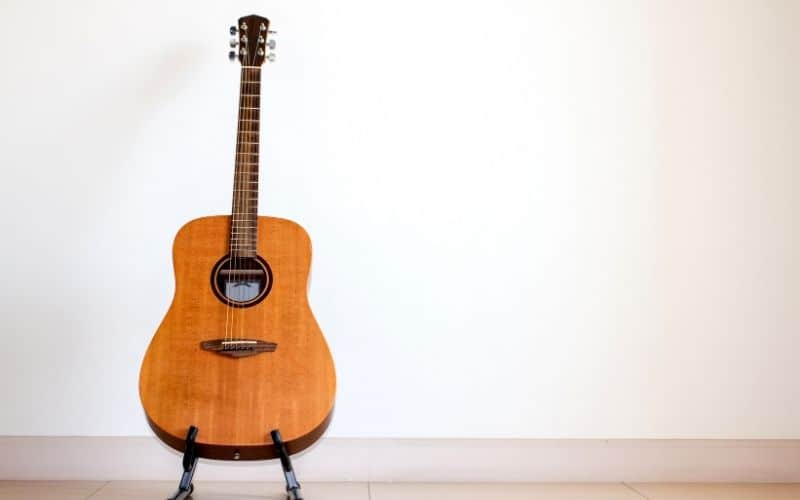
1) Nitrocellulose Can Chemically React with the Guitar Stand
To put it simply, guitars that use a nitrocellulose finish will degrade over time, giving the guitar that awesome vintage appearance like it has been played by a professional for years.
While nitrocellulose guitar finishes look incredible once they’ve worn down and the guitar has that special “used” look, this finish is more vulnerable to chemical reactions, like with the rubber used by guitar stands, for example.
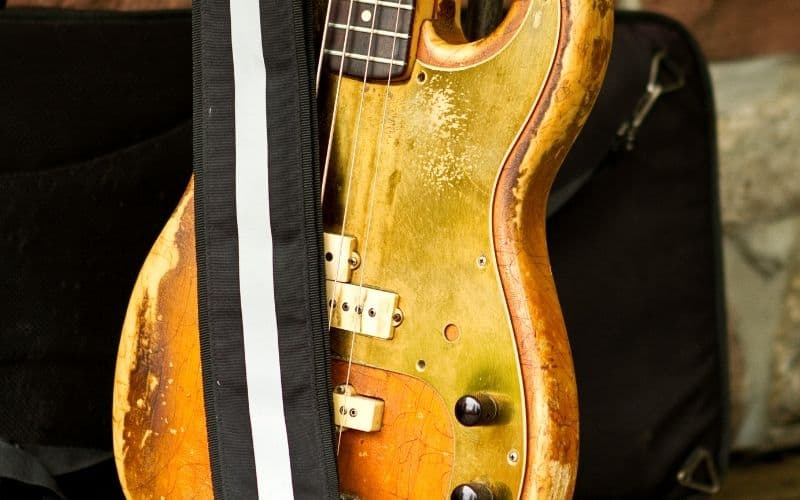
If you leave a guitar that uses a nitrocellulose finish on a non-nitro-safe stand, it’ll end up leaving a nasty mark on the guitar, and not the kind of vintage mark that looks cool.
It will look more like a nasty, black, mark that’s caused by a chemical reaction between the nitrocellulose and the chemicals used in the rubber of the stand.
Explained another way, nitrocellulose finishes do look awesome when they’ve slowly worn down over time, however, they’re also more vulnerable.
It’s one of the reasons why some people think that nitrocellulose is inferior to polyurethane finishes, which tend to last forever and don’t degrade easily. Additionally, polyurethane finishes don’t have that same reaction to the rubbers of guitar stands.
Nitrocellulose Finish Overview
At one point in time in history, guitar manufacturers in the 1950s and the 1960s (and probably before) used nitrocellulose lacquer paints to make their guitar finishes.
It also came as part of a painting technique that was formerly employed by the same manufacturers, but they have since stopped making them in this way, as Steve from Steve’s Guitar guy explains, unless it’s a custom shop or higher-end model where the client specifically suggested a nitrocellulose finish.
Using a nitrocellulose finish is more time-intensive which takes many sandings, multiple coats, time, and resources.
It’s not hard to imagine that using a nitrocellulose finish is more expensive as a result, and it’s one of the reasons why manufacturers stopped using nitrocellulose for their most ubiquitous models. They just couldn’t afford it, or maybe they could, but they’d rather cut the costs and increase profits.
Either way, all of that is beside the point. Nitrocellulose finishes, while they look EXTREMELY cool after they’ve been played a lot, aren’t as invulnerable as polyurethane finished guitars. There’s a good chance that a nitrocellulose guitar will react to the stand in which it sits.
2) Cheap Guitar Stands Are Too Compact
Cheap guitar stands aren’t worth the money, in my opinion. However, they’ll work just fine if you’re just starting out and you don’t want to spend yet even more money on accessories for your gear.
As time passes, you’ll probably own more guitars and your needs will become more specific and nuanced, so a cheap stand will no longer do the trick. I’ve found that to be the case for the stand that you can see in the image here:
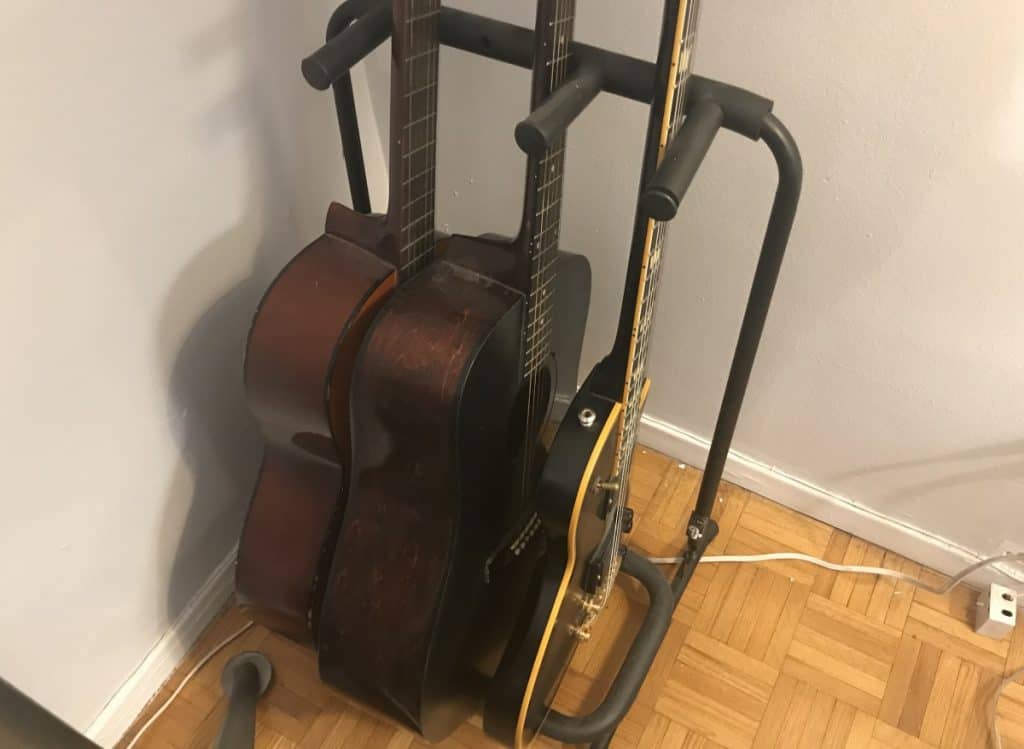
This was a great guitar stand for 1-3 years, but I started to get really annoyed with it once it started falling apart.
For example, you can see that parts of it have fallen off including key parts that hold the guitars in place. I find that whenever I pull a guitar off of this stand, the strings get caught on the pegs which is very irritating.
In general, it’s just not a quality stand. And this Yorkville stand down below isn’t a great one either. The back leg, for example, is far too short, making it fairly vulnerable to getting knocked over or bumped by someone walking by.
If you are going to get a stand, make sure the legs, including the back one, are long and thick.
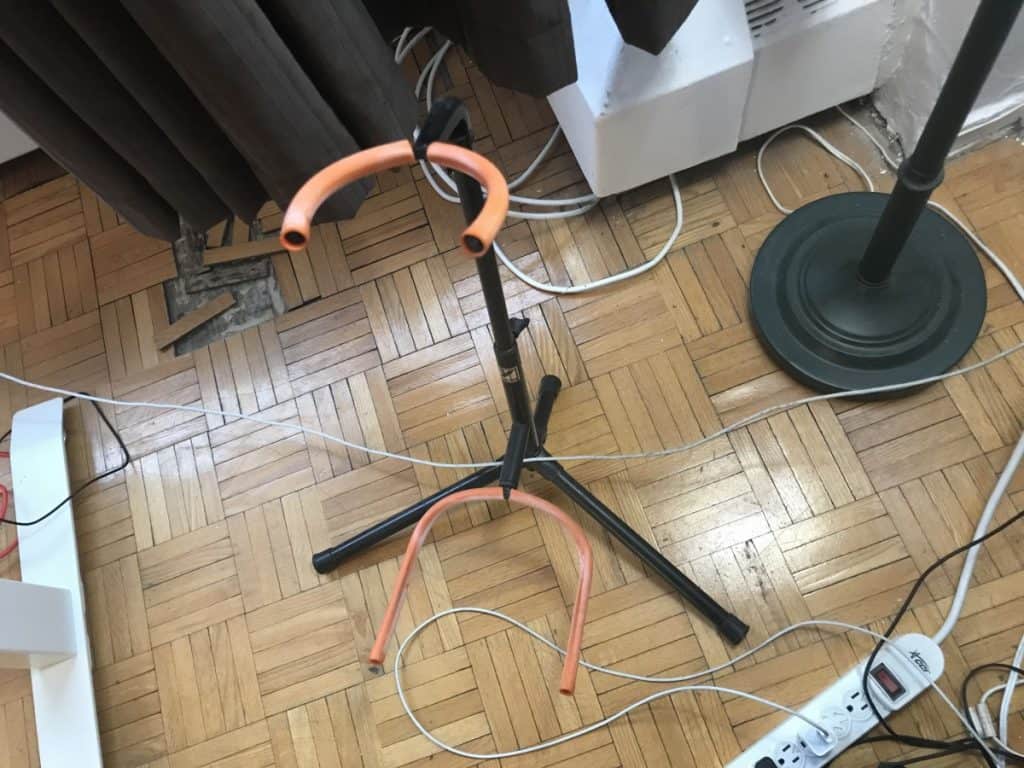
Once you own several more expensive guitars, it would be wise to purchase a guitar stand that’s very high quality and at least claims to be nitrocellulose safe in case you’re using a very old or very expensive guitar, which nitrocellulose guitars tend to be.
Otherwise, you’ll find yourself in weird situations like having the strings get caught on the stand or having a nasty black mark on the neck.
3) Cheap Guitar Stands Are Notoriously Unstable
I’ve heard a few professionals say now that if you’re using a cheap guitar stand, it’ll probably work just fine if the guitar is standing in an area where there isn’t a lot of people walking around.
But if the guitar is sitting in a location with a lot of traffic, it would be much wiser to have a stand that’s sturdy and durable. That way if someone bumps it, it’ll stand exactly where it’s supposed to.
As I briefly mentioned earlier, one of the ways you can judge this is to take a look at the legs at the bottom of the stand.
A sturdy, more serious stand, will have long and thick-looking legs at the bottom of it which keep it from getting easily knocked over by small children and other people. A great stand for this is the Hercules stand which you can see in the image down below:

This isn’t the only one either. There are many different stands on the market that are very stable and durable, including the commonly recommended Fender Deluxe Stand which you can grab elsewhere. This is another great stand that’s heavy and thick on the bottom.
Important Things to Note About Guitar Stands and Nitrocellulose
1) Nitrocellulose and Possible Chemical Reactions are Unpredictable
There are a lot of companies out there that claim their products and stands are nitrocellulose safe, however, you never know what can happen.
I remember reading the statement from one reputable brand who said it was impossible for them to say their stands would be 100% reliable whilst holding nitrocellulose instruments.
Simply put, it might be wise to stitch on a piece of towel behind the neck to keep your guitar finish safe, rather than trust the marketing and advertising of a brand that wants your money and really won’t care if the finish on your neck is ruined.
For years, (or at least before I realized that I didn’t have a guitar with a nitrocellulose finish), I would put a towel behind the guitar neck because I was worried about the finish.
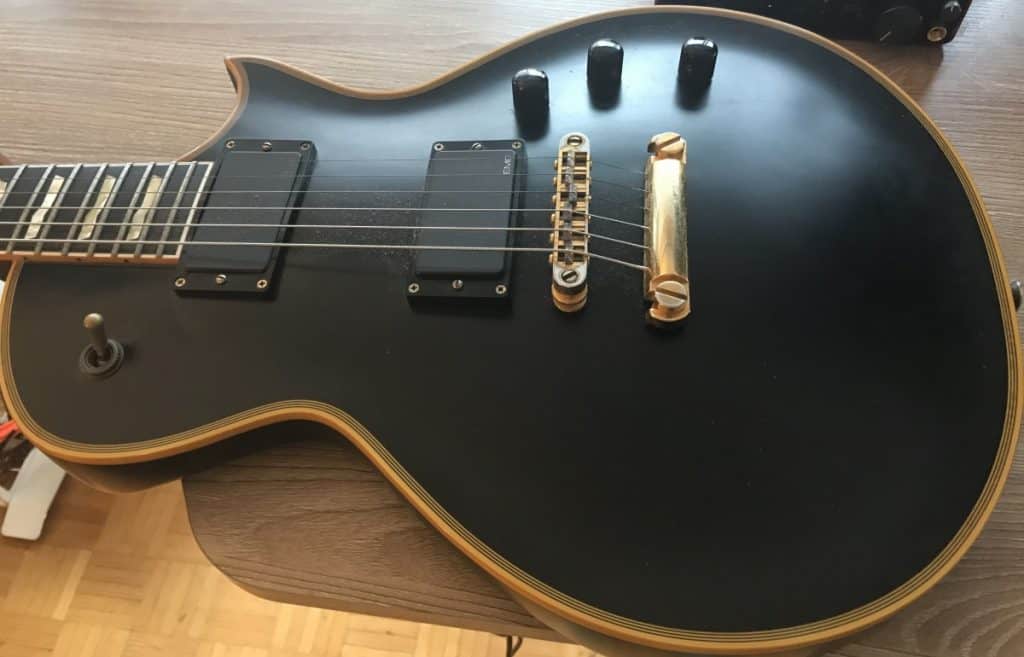
It turns out that my favorite guitar, the ESP Eclipse II, has a polyurethane finish and not a nitrocellulose finish so I didn’t have to worry about it anyway. Regardless, the point I’m getting at is that you’ll probably be ok if:
1) you put a towel behind the neck, assuming you have a very old or very expensive guitar ($4000 and up) with a nitrocellulose finish, or…
2) you have a much cheaper guitar ($2500 and below) which probably doesn’t use a nitrocellulose finish anyway.
Either way, I’d say it’s best just to get your hands on a solid stand like the Hercules one that I mentioned if you have multiple guitars or the Fender Deluxe Stand if you only have one. At the end of the day, your guitars will probably be alright.
If you have an older or more expensive model, use a quality stand, but if you’re a beginner, it’s probably not worth worrying about unless you know for a fact that it has a nitrocellulose finish.
It’s kind of like the way some people fret over the purported toxicity of guitar strings (which I’ve written about before). Maybe there is a risk, but it’s so incomprehensibly small that it’s not worth thinking about.
YouTube Video Tutorial
Gear I Mentioned
Each link takes you to Amazon
1) Hercules Guitar Stand
2) Fender Deluxe Guitar Stand
3) ESP Eclipse II
Other Articles You May Be Interested In


 Written By :
Written By :
